|





Despite the
great interest in the subject, you could probably count the number
of serious prototype collectors on two hands. It's my hope that
this section will help shed some light on how to find and identify
authentic NES prototypes so that more people can join in and find
the confidence to buy a prototype of their own.

  Visual
approximations of three typical, serious Nintendo prototype buyers. Visual
approximations of three typical, serious Nintendo prototype buyers. 
I should start
off by saying outright that, from personal experience, when it
comes to finding differences in prototypes of released games,
more times than not they are real heart breakers—it's like
playing the lotto every time you buy a prototype, except that
the tickets cost at least a hundred bucks a piece. (Of course,
you don't have this problem with a prototype of an unreleased
game, but you'd then have to spend much more money to have that
peace of mind.)
What I would
recommend to newcomers interested in prototype collecting is if
you have a certain video game in mind that you love enough that
you'd feel comfortable spending the necessary funds to rescue
it, I say, more power to you. If all you want is an historical
record of your favorite game, seeing major differences is always
nice, but you won't be too disappointed if you can't find any
as you still have a unique copy of a title that you love. And
isn't that what's really important in life: the loving?
With prototypes
of released games, it's all about hedging your bets and having
reasonable expectations. I wish there were surefire signs that
would point you in the direction of a prototype containing changes,
but nothing is a guarantee in the world of prototypes as you're
about to see.
The first
general rule for buying prototypes is, unless solid provenance
is given and can be backed up, you should never bid on or purchase
any prototype without first seeing the PCB inside of the cartridge
to determine whether the prototype is, indeed, real. From a hardware
standpoint, become acquainted with BootGod's
extensive database of scans in order to compare the released
and prototype PCBs.
Another general
rule is to familiarize yourself with the release dates of the
prototypes that you're interested in. Nintendo compiled a list
of all officially licensed NES titles, complete with release dates,
in this .pdf file. Many
prototypes are dated either on the label or on the inside. The
further away the date is on the prototype from the release, the
better your chances are of finding differences. Prototypes dated
a month or two before release are most likely review copies sent
to gaming publications and will be close to (if not identical)
to the released game (although there could be a debug menu, invincibility,
or level select capabilities).
As for the
online market pricing of released game prototypes, those for the
NES usually cost more than any other system. For prototypes of
terrible games (i.e. Total Recall terrible), you might
be able score one for as low as $50. Prototypes of average, run-of-the-mill
games generally go for between $75-$150. For prototypes of more
popular or rarer games, you're looking at $150-$250+. Major first
party Nintendo games can reach prices much higher. These price
points are common knowledge in the collecting hobby, which means,
if there's a prototype on an auction site that you really, really
want, you should plan on waiting until the last minute to bid
an amount considerably higher than these given estimates to ensure
that you stomp out the competition.
The best way
of helping you to identify authentic prototypes is by listing
some examples that have come into my hands. That way I can tell
you if any changes were found while you learn about the different
kinds that are out there. Please note that this is not to say
that all prototypes follow the guidelines of those listed below;
I am simply sharing my own personal experience to help guide you
when you're starting out.

  A
Boy And His Blob with standard prototype label. A
Boy And His Blob with standard prototype label. 
This A
Boy And His Blob prototype has a standard Nintendo prototype
label on the front of the cartridge. You might be asking yourself,
"What does the "NES-P-B5" at the top stand for?"
The next time
you pick up an NES licensed game, look closely at the label on
the cartridge. You should see a code similar to this one printed
in a small font. Every licensed NES game is catalogued using a
unique ID, with the last part of the code pertaining to the game's
region. For example, the catalogue code for A Boy and His Blob
released in America is NES-B5-USA.
On many prototypes
with this kind of label, the region (i.e. "USA") is
normally left out and replaced with the letter "P" in
its place, and instead of appearing last, the "P" is
usually in the middle of the code.
Here are a
few more examples: a protoype of
Kabuki Quantum Fighter has the code "NES-P-3K"
(US game ID: NES-3K-USA); Little
Nemo The Dream Master is marked "NES-P-LN" (US
game ID: NES-LN-USA); and Nintendo
World Cup has "NES-P-XZ" on its label (US game
ID: NES-XZ-USA).

  Official
Nintendo TKEPROM Prototype Board: Check. Official Nintendo Prototype
Stickers: Double Check. Official
Nintendo TKEPROM Prototype Board: Check. Official Nintendo Prototype
Stickers: Double Check. 
Inside of
all four of these examples are official Nintendo copyrighted NES-TKEPROM
PCBs. Seeing an NES-TKEPROM board is very good confirmation of
a prototype's authenticity as these type of boards are found only
in prototypes. As I mentioned before, the majority of prototypes
have one or two EPROMs (or sometimes more like, for example, one
known prototype of The Legend of Zelda). These EPROMs require
a special EPROM board for them to work. To go back to the CD analogy
again, just as you can only copy files onto a CD-RW disc with
a CD-RW burner (and not with a CD-R burner), you cannot use EPROMs
on a regular production board (at least, not without additional
modification that I'll talk more about shortly).
On top of
there being official Nintendo prototype boards, these examples
have their CHR and PRG EPROMs covered by Nintendo-branded stickers
in a festive red and blue ensemble. Shy of Shigeru Miyamoto signing
his name with his telephone number on the front of the cart,
you would be hard pressed to find any more proof of legitimacy
than with an official Nintendo prototype label on a cartridge
holding an official Nintendo prototype board with official Nintendo
prototype EPROM stickers inside.
Having said
that, if you're out looking for changes, all four games previously
mentioned were found to be completely identical to their respective
final, released games.
Another common
standard prototype label you might see is one that's white (or
discolored yellow by age) and reads "*USA
VERSION* (FINAL/NTSC)" on the front label. I have not
personally bought any of these type of prototypes for the NES,
but I do have a Super Nintendo prototype of Super
Mario All-Stars that features the same label and wording,
and that turned out to be identical to the final game, as well.

  DuckTales:
Woo Hoo! DuckTales:
Woo Hoo! 
NES-TKEPROM
boards are not the only official Nintendo prototype PCBs. This
DuckTales prototype demonstrates another example: an
NES-UNEPROM PCB. This is another
board found only in prototypes and is also a good way of authenticating
a prototype. DuckTales, by the way, was found to be the
same as the released game.
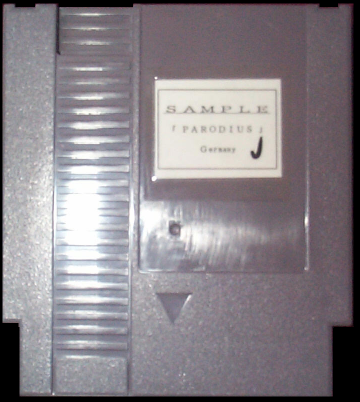
  Parodius
PAL prototype on NES-TKEPROM
PCB. Parodius
PAL prototype on NES-TKEPROM
PCB. 
Prototypes
in the NTSC format (North American region) are most sought after,
while those in the PAL format (European region) generally do not
go for as much money. Why is that? For one, most prototype collectors
are located in the US. Two, NES games were sometimes released
in North America months (or even years) in advance of the European
release, thereby making differences in PAL format prototypes from
the final games harder to come by.
How can you
tell if a prototype is in the PAL format? If it's not stated on
the label or on the EPROM stickers, another indication is if a
European country is mentioned anywhere inside or outside the prototype.
The prototype pictured above is labeled "SAMPLE [ PARODIUS
] Germany," making it quite clear that the prototype
is PAL formatted. Parodius, by the way, was found to be
different from the released game.
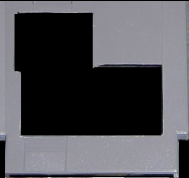 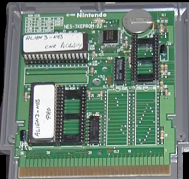
  Aliens
3 prototype on NES-TKEPROM PCB with socketed EPROMs and cutout
cartridge. Aliens
3 prototype on NES-TKEPROM PCB with socketed EPROMs and cutout
cartridge. 
Other prototypes
won't be as cosmetically neat as the previous examples. Some might
even have their cartridges cut out so you can see the PCBs inside.
This was done mostly for EPROMs that were socketed because the
use of sockets can raise them up, making it difficult to close
the cartridge. (Also, the cutting away of plastic allowed developers
easy access to the EPROMs inside instead of having to unscrew
the cart every time from the back.)
Whenever I
see a prototype with sections of its cart's plastic drilled away—essentially,
if the thing looks like it's been through a trash compactor or
took a few bullets in its day—I get excited. My philosophy
is the worse a prototype looks, the better off your chances are
of finding differences. However, nothing is a guarantee, as some
prototypes with soldered EPROMs in clean carts have yielded some
amazing changes, too (as well as completely unreleased games).

  Teenage
Mutant Ninja Turtles II: The Arcade Game prototype on TLROM-02
PCB. Teenage
Mutant Ninja Turtles II: The Arcade Game prototype on TLROM-02
PCB. 
Not all prototypes
use special prototype boards like NES-TKEPROM or NES-UNEPROM.
In the example shown above of Teenage Mutant Ninja Turtles
II: The Arcade Game, you will see that the CHR and PRG EPROMs
are on a PCB marked TLROM-02.
Notice the word "ROM" instead of "EPROM".
This PCB is a regular, old MROM-based PCB! That's right, some
prototypes are on production PCBs (meaning, PCBs you would find
inside of any normal cart).
You might
be asking yourself, "But, wait! How is that possible? You
said that erasable EPROMs don't work on regular PCBs meant for
permanent storage of data, just as you can't burn CD-RWs in a
CD-R drive! How can EPROMs operate in a non-prototype PCB?"
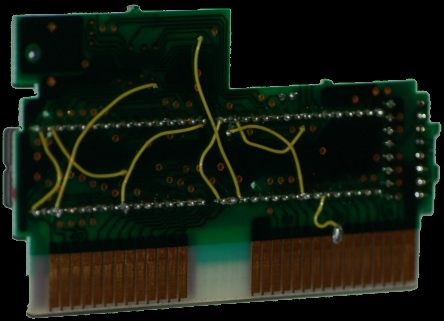
  This
TMNT II ROM board was meant to take only MROMs, but has been
modified with solder and wires to allow EPROMs. This
TMNT II ROM board was meant to take only MROMs, but has been
modified with solder and wires to allow EPROMs. 
In the case
of this TMNT II, the answer can found on the back of the
PCB. With extensive soldering and wiring, this PCB has been turned
from an otherwise normal production board into one modified to
accept EPROMs. (TMNT II was found to be different from
the released version.)
I will go
more into why you should be careful of prototypes with non-prototype
PCBs (i.e. regular MROM production PCBs like this one) in a later
section on prototype scams, but make a mental note for now that
NES reproductions use a similar process of converting regular
PCBs to handle EPROMs. Be extra cautious and inquire about the
provenance when in doubt about a prototype using a non-prototype
board.

  Jaws
prototype on regular PCB without EPROMs.
Click here for
the non-prototype, released PCB. Jaws
prototype on regular PCB without EPROMs.
Click here for
the non-prototype, released PCB. 
If seeing
EPROMs on MROM board wasn't confusing enough, believe it or not,
prototypes can also come on regular PCBs without any modifications
and without any EPROMs (this includes prototypes of both released
and unreleased games). This kind is the most problematic to try
to authenticate because, frankly, when you compare, say, the prototype
PCB of this Jaws prototype with a copy of the released
PCB game, there's really no visual difference between the
two.

  A
number of LJN Sample
Game Paks (Gotcha!, The Karate Kid, etc.) have been
found in Canada, including this one of Jaws.
All have the same kind of label and use MROMs. A
number of LJN Sample
Game Paks (Gotcha!, The Karate Kid, etc.) have been
found in Canada, including this one of Jaws.
All have the same kind of label and use MROMs. 
Note that
this Jaws prototype was found to be identical to the released
version.
My personal
recommendation is to avoid any game advertised as a prototype
that does not have at least one EPROM in it unless solid provenance
is given. If it's an LJN prototype with a label like this—
it's legit—but just know that chances are it will not have
any differences and it's most likely the same as the final game.
If you're looking to get your hands on a prototype of an LJN game
that has a better chance of containing differences, look for a
white label that says "This is a Preproduction Sample and
must be returned to LJN as soon as possible" on the front
of the cartridge.
Since we're
on the subject of prototypes with company-specific labels, here
is a list of some examples to be on the look out for:
- Acclaim
- Activision
- Capcom
- Hudson
Soft
- LJN
- Nintendo
- RARE
- SUNSOFT
- Taito
- Tengen
- Ultra/Konami
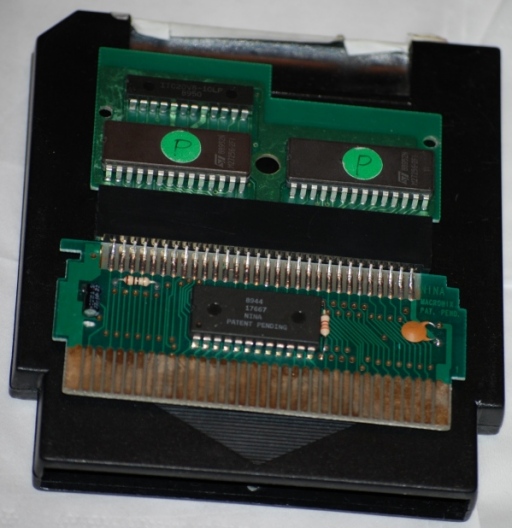
  This
unlicensed AVE prototype of Puzzle uses AVE's patented NINA
adapter. This
unlicensed AVE prototype of Puzzle uses AVE's patented NINA
adapter. 
Up to this
point I have only discussed licensed game prototypes. For all
of you unstamped seal of quality game enthusiasts, rest assured
that there are plenty of unlicensed prototypes out there, too.
As you can see pictured above, this Puzzle
prototype is unlike any other prototype we have seen so far. Of
course, since it's an unlicensed game, there's no official Nintendo
PCB. What makes this prototype strange is it's actually a Famicom
PCB attached to a 60-pin Famicom to 72-pin NES adapter. AVE had
a shorter name for this device: a NINA adapter. (With all of this
going on, closing the cartridge is next to impossible!)
Other than
this one AVE example, to be quite honest, I'm not going to be
much help when it comes to unlicensed game prototypes. (I guess
I've never been too much a fan of unlicensed games in the first
place.) When in doubt, you can consult BootGod's
database of carts to compare the PCBs of the prototype and released
versions. Just remember that unlicensed game companies used EPROMs
on their regular games, so seeing EPROMs on a PCB does not necessarily
make the unlicensed game a prototype.

  Prototype
of the unreleased game Drac's Night Out featuring the Reebok
Pump. Prototype
of the unreleased game Drac's Night Out featuring the Reebok
Pump. 
A programming
note: You're going to see a lot of gross watermarks on these unreleased
prototypes. That's because many of the owners only granted me
permission to post these photos if I plastered the site's URL
all over them to prevent potential scammers from taking the photos
and tricking people with bogus sales and auctions.
A prototype
of an unreleased title is a whole other animal from a released
game. I would venture to guess that the average game player has
little interest in knowing that a DuckTales prototype has
cheeseburger power-ups instead of vanilla ice cream cone power-ups.
But a game never released for public play? Suddenly everyone's
interest is piqued. When a prototype of an unreleased game materializes
on an auction site like eBay, quickly grab an umbrella, because
money is about to start raining down hard.
The term "unreleased"
has been debated in some cases. For example, would you consider
an NTSC region coded prototype of a PAL-only game like Gimmick!
an unreleased game? It's the same game as the wide European release,
except now it can be played in a North American NES system. Does
that warrant the "unreleased" moniker? According to
collecting circles, it does, thereby making such a game significantly
costlier than your average prototype.
When you're
dealing with undumped prototypes (meaning, there's no ROM image
available to download on the Internet and play on an emulator)
of NES games that have never been released in any region of the world, you are looking at a price
tag in the thousands of dollars. It wasn't always this way, but
the prices have steadily gone up over the years.
Here's a short
list of some legitimate prototypes of unreleased NES games:

If you're
feeling really lucky, there have been stories from time to time
of very fortunate people stumbling upon prototypes at flea markets
or yard sales. Get to better know your surrounding area and its
history. Many prototypes originate from companies sending copies
of their games off to publications that previewed or reviewed
them. Are there/were there any such publications in your area?
Perhaps you might even live near one of the areas where NES games
were once developed. Consult the Nintendo
Licensee Address Book to see if any game developers were (or
still are) in your neck of the woods.
It goes without
saying that if by any chance you are ever blessed enough to come
across a prototype in the wild, you should do your best Mario
impression and jump on it (not literally, I mean, buy it!). To
confirm that it is a prototype, purchase a 3.88 MM screwbit to
take apart the cartridge from the back. You should also buy a
few small flathead and Phillips screwdrivers to keep handy just
in case you're faced with another kind of screw.
My favorite
prototype find story of them all is Brandon Murphy's. Brandon
walked into a game store in Orlando to find an unsuspecting
mother about to sell a box full of video game prototypes to a
greedy clerk. Brandon spoke up and told the woman about
the value of her games, and recommended that she not sell them
to the store. For this, Brandon was thrown out by
the employee. The woman followed Brandon outside shortly thereafter
with her box of prototypes still full and rewarded him for his
honesty by allowing him to choose one of the games for himself.
This was how California Raisins was finally found (read
the whole story as told by Brandon, himself).
If you are
like me and live in a congested area of the country, and so have
never had any luck in finding rare games, your best bet is to
keep a close eye on auction sites like eBay. Search
terms for finding prototypes include: "dev," "sample,"
"proto," "prototype," and "demo,"
etc. Keep these searches bookmarked so that you can check regularly.
The downside
of relying on auction sites?

This is a
classic example of some of the ridiculous pricing that you are
bound to run into when searching for prototypes online. Here is
an eBay seller attempting to sell a Swamp Thing NES prototype
for $800. This person is clearly insane.
No matter
how rare prototypes are said to be, no one reasonable is ever
going to spend that much money on a prototype of a released T*HQ
game. (Recall that these are the same bastards that gave us games
like Where's Waldo? and The Adventures of Rocky and
Bullwinkle and Friends.) Besides, on the rarity: More and
more prototypes come out of hiding every year, and the ones that
are already known to exist have a tendency to change hands quite
frequently. Who can say for sure if that one-of-a-kind proto is
really many-of-a-kind or currently up for sale right now?
Now is as
good a time as any to talk about the importance of a prototype's
provenance. To find the provenance of a prototype such as this
Swamp Thing, there are a number of resources you can search.
NES World
features a large listing of prototypes. The
Warp Zone does, too. There's even a smaller directory of prototypes
on this very site
you're on right now. I consider both webmasters of NES World
and The Warp Zone prototype experts, so I trust that the protos
they have listed are legitimate, but you should always do your
own evaluation, too. As far as the prototypes listed on this site
are concerned, they all have provenances that range from established
prototype collectors to even a former Spanish Nintendo gaming
magazine. If you still can't find a proto's lineage, proceed with
caution and ask the seller for more details. Post on forums that
have proto-specific sections, like Digitpress.com,
for a second opinion.
In the case
of the Swamp Thing here, The Warp Zone yields a photo of
the very same prototype as the one pictured in the auction, even
mentioning that it had previously sold on eBay before for $120
(link).
Sellers who
put random phrases like "not factory sealed" in the
title of a prototype auction are generally not expecting anyone
to take their auction seriously and pay such an exorbitant price
for the item. Listing a rare game like this serves as a way to
advertise the rest of the seller's auctions by getting you to
click. In the case of this seller, he or she wanted you to see
the wide array of sealed NES games also for sale (as well as apparently
this "hooters chicken wing tray ceramic
owl"—absolutely no returns accepted on the Hooters
ceramic owl, by the way).
Clearly, clearly
insane.

A helpful
resource to track prototype auctions is GameSniped.com.
Nicola and the staff there post several auctions of rare games
every day. Know that with more media exposure comes higher prices,
as popular gaming blogs like Kotaku
often link to auctions spotlighted on GameSniped (such as the
above mock-up cover of the unreleased New Kids On the Block, which came out of the offices of Electronic Gaming Monthly).
Another way
to find prototypes is by keeping a close eye on video game messageboards
that have prototype-specific boards. Digitpress.com
and ASSemblerGames.com
are two well-known examples. Keep a close eye on marketplace threads
to see what's selling.

Yahoo!
Japan Auctions is a secret playground where Famicom and Famicom
Disk System prototypes come to play. This is where the elusive
(and unreleased) Bio Force Ape was found and purchased.
You can regularly find at least one Famicom prototype up for auction
at any given time. Because Yahoo Japan does not allow international
bidders, it is necessary to sign up with a Japanese deputy service
like Rinkya or Shopping
Mall Japan to bid on auctions there (and to get the auction
descriptions translated into English). Although prototypes on
Yahoo tend to go for much less than American auction sites like
eBay, do not forget to factor in all of the deputy service fees
and the extra shipping costs.
No matter
how you find that prototype you've always wanted, before you make
the purchase, consult the next section to avoid some common scams.

|

